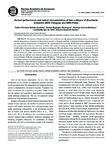Please use this identifier to cite or link to this item:
http://www.alice.cnptia.embrapa.br/alice/handle/doc/1061652Full metadata record
| DC Field | Value | Language |
|---|---|---|
| dc.contributor.author | EUCLIDES, V. P. B. | pt_BR |
| dc.contributor.author | MONTAGNER, D. B. | pt_BR |
| dc.contributor.author | BARBOSA, R. A. | pt_BR |
| dc.contributor.author | VALLE, C. B. do | pt_BR |
| dc.contributor.author | NANTES, N. N. | pt_BR |
| dc.date.accessioned | 2017-01-24T11:11:11Z | pt_BR |
| dc.date.available | 2017-01-24T11:11:11Z | pt_BR |
| dc.date.created | 2017-01-24 | pt_BR |
| dc.date.issued | 2016 | pt_BR |
| dc.identifier.citation | Revista Brasileira de Zootecnia, v. 45, n. 3, p. 85-92, 2016. | pt_BR |
| dc.identifier.uri | http://www.alice.cnptia.embrapa.br/alice/handle/doc/1061652 | pt_BR |
| dc.description | The objective of the present study was to evaluate live weight gain per animal and per area and its relationship with the characteristics of pastures of Brachiaria brizantha cv. Paiaguás and Piatã. A randomized blocks experimental design was used, with two treatments and six replicates. The experimental area was 8.0 ha, divided into twelve paddocks of 0.67 ha. The grazing method used was continuous stocking, with variable stocking rate. Three tester steers were used per paddock. Sward heights were measured once a week, and the stocking rate (SR) was adjusted using regulator steers to maintain the sward height at 30 cm. Pasture samples were collected once a month, and herbage accumulation rate (HAR), percentage of leaves (PL), leaf:stem ratio (LSR), and nutritive value (NV) were determined. Animals were weighed every 28 days. No differences between the two cultivars were observed during the wet season for any of the evaluated parameters. However, cv. Paiaguás presented higher HAR and, consequently, higher SR than cv. Piatã during the dry season. As a result of its higher regrowth, cv. Paiaguás pastures presented significantly higher PL, LSR, and NV and, consequently, significantly higher average daily live weight gain. These differences resulted in higher live weight gain per area for Paiaguás grass (695 kg/ha per year) than for Piatã grass (645 kg/ha per year). Thus, Brachiaria brizantha cv. Paiaguás is a good alternative to decrease the temporary forage shortage and for the diversification of pastures in the Cerrado biome region. | pt_BR |
| dc.language.iso | eng | eng |
| dc.rights | openAccess | eng |
| dc.title | Animal performance and sward characteristics of two cultivars of Brachiaria brizantha (BRS Paiaguás and BRS Piatã). | pt_BR |
| dc.type | Artigo de periódico | pt_BR |
| dc.date.updated | 2017-03-03T11:11:11Z | pt_BR |
| dc.subject.nalthesaurus | Canopy | pt_BR |
| dc.subject.nalthesaurus | Nutritive value | pt_BR |
| dc.subject.nalthesaurus | Stocking rate | pt_BR |
| riaa.ainfo.id | 1061652 | pt_BR |
| riaa.ainfo.lastupdate | 2017-03-03 | pt_BR |
| dc.contributor.institution | VALERIA PACHECO BATISTA EUCLIDES, CNPGC; DENISE BAPTAGLIN MONTAGNER, CNPGC; RODRIGO AMORIM BARBOSA, CNPGC; CACILDA BORGES DO VALLE, CNPGC; NAYANA NAZARETH NANTES, UFMS. | pt_BR |
| Appears in Collections: | Artigo em periódico indexado (CNPGC)  | |
Files in This Item:
| File | Description | Size | Format | |
|---|---|---|---|---|
| Animalperformanceandswardcharacteristics.pdf | 1,61 MB | Adobe PDF |  View/Open |









